5 Real Examples of Sales Funnel in eCommerce + Best Practices [2026]

Every business function needs a system and strategy, and so does the sales function.
A “sales funnel” is that system and strategy for your business.
Building a sales funnel gives your business a systematic approach to converting your target customers into your actual customers — and even helps with making them your loyal customers.
In this blog post, we’ll help you with examples of sales funnel in eCommerce business models along with pro tips and best practices to create your own sales funnel.
Let’s start with the basics first:
What is a Sales Funnel in eCommerce?
A sales funnel is a marketing strategy created to walk customers through a journey—consisting of subsequent stages—from making them aware of your product/service to enticing them to buy it.
Depending on the business model, the subsequent stages may vary to some extent. Typically, an eCommerce sales funnel has the following stages: Awareness, Interest, Evaluation, Desire, Sale, and Retention.
Learn more: Referral Marketing: Ultimate Guide to Drive Sales and Traffic
Stages of a sales funnel
A sales funnel is typically divided into three main stages:
-
Top of the Funnel (ToFu): This stage includes your target audience who may know about your brand but aren't currently ready to buy.
-
Middle of the Funnel (MoFu): These are potential customers who have visited your website and are considering products or services similar to yours.
-
Bottom of the Funnel (BoFu): This final stage is for new and existing customers who are ready to make a purchase with the right encouragement.
It's important not to confuse a sales funnel with a marketing funnel. A marketing funnel focuses on building brand awareness and engaging your audience, while the sales funnel begins once those individuals become qualified leads.
Why Is a Sales Funnel Important?
A sales funnel is crucial because it helps you understand what customers are thinking, feeling, and needing at every step of their journey. This knowledge allows you to optimize your website and internal processes.
By providing customers with relevant content and offers at each stage, your team can improve their experience, leading to higher sales and better customer retention.
Learn more: Introducing New Feature: GemPages Sales Funnel - Ultimate Solution for Maximizing Your Shopify Store Profit
What is the Typical eCommerce Sales Funnel Example?
Chances are your Shopify or eCommerce store already has some sort of basic sales funnel. For example, you might have a newsletter sign-up form embedded into your footer section which can help you send marketing emails.
So, why focus on building a new sales funnel?
The main goal is to optimize your sales funnel for conversion and to make sure there are no leaks in your funnel that would drive a potential customer away from purchasing your products or services.
Here’s an example explaining how a typical eCommerce sales funnel may work in one of the ideal scenarios:
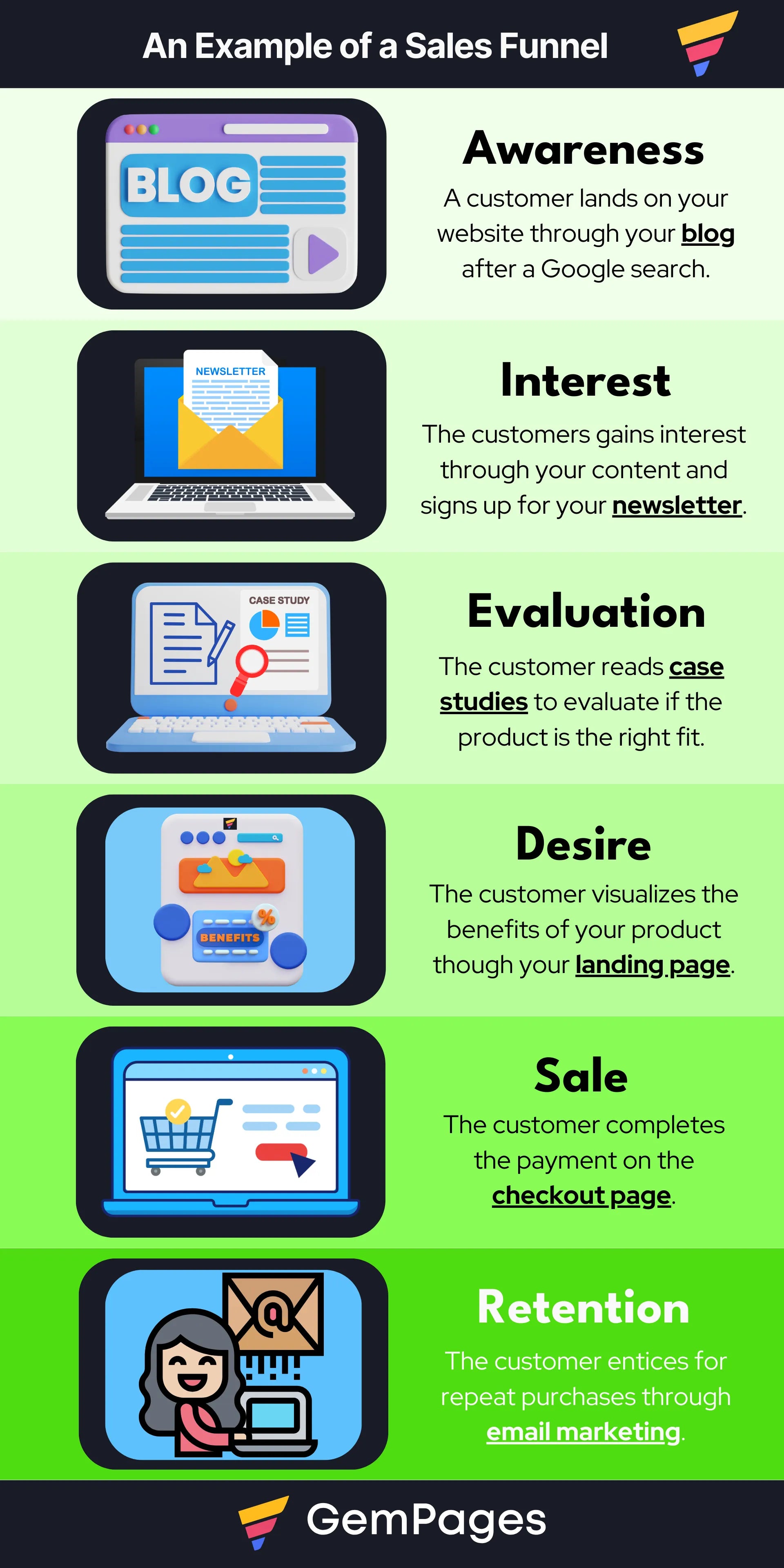

Best Real-Life Examples of Sales Funnel in eCommerce
Okay! So, we just saw a hypothetical example above. Now, it’s time to look at some real-life examples. By the way, we haven’t just taken random sales funnel examples with a screenshot of the newsletter form but reviewed them in detail.
Also, to give you an idea of the various possibilities, we have curated some great eCommerce sales funnels examples that are powered with different channels and marketing strategies including —
- Social Media Marketing
- YouTube
- Content Marketing
- Blog Content
- eBook Lead Magnet
- Email Marketing
- Newsletter
- Email Guide
1. Huel’s Sales Funnel with Instagram Shop
Huel is one of the most popular Shopify-powered brands in the world. The brand aims to provide its customers with nutritious plant-based food.
Huel uses its massive Instagram following as one of its sales funnel strategies. The brand’s Instagram page has the Shop channel configured so that customers can check out the brand’s offerings right from there.
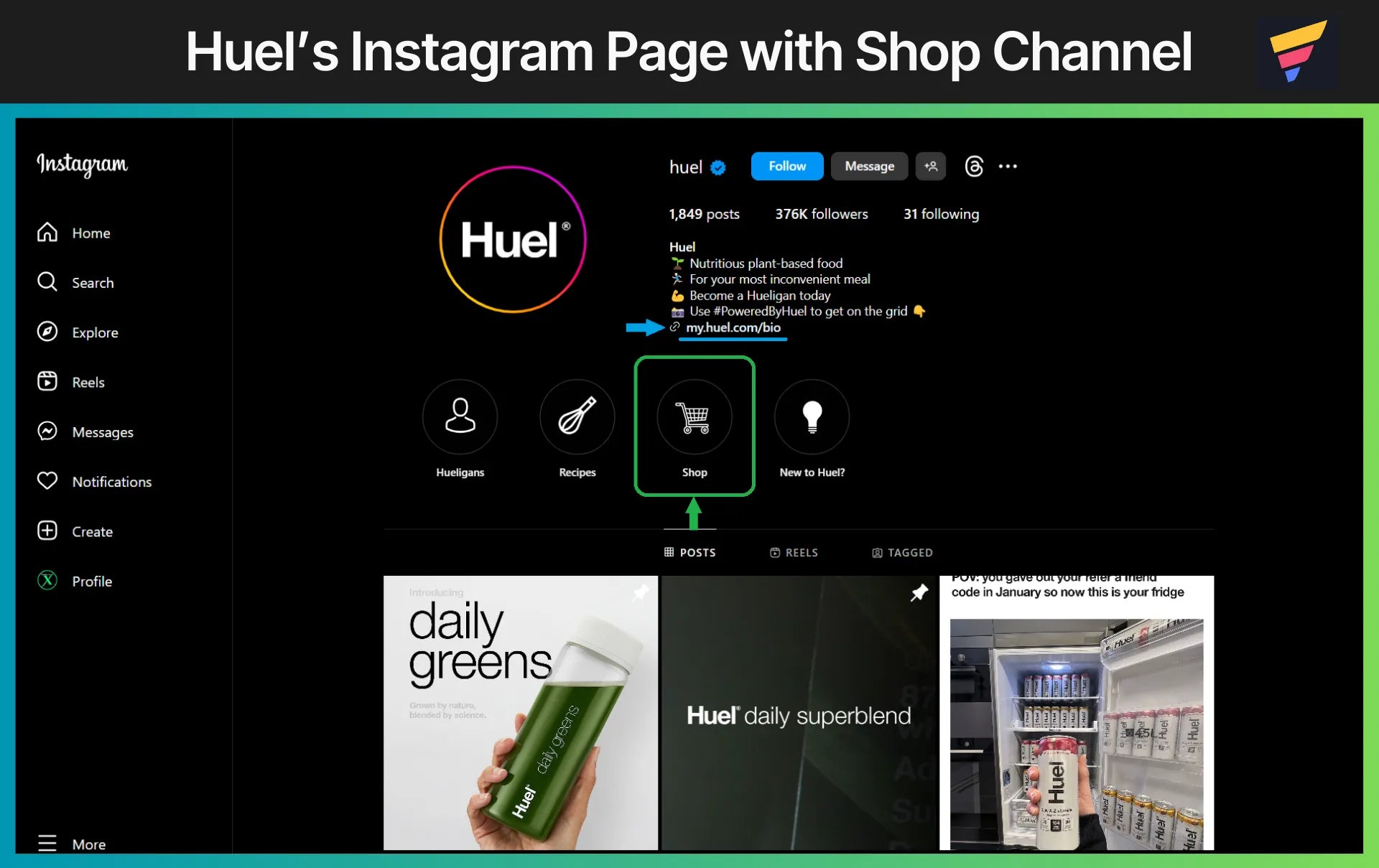
When you click on that Shop widget, you’ll see different posts/stories with product images and links.
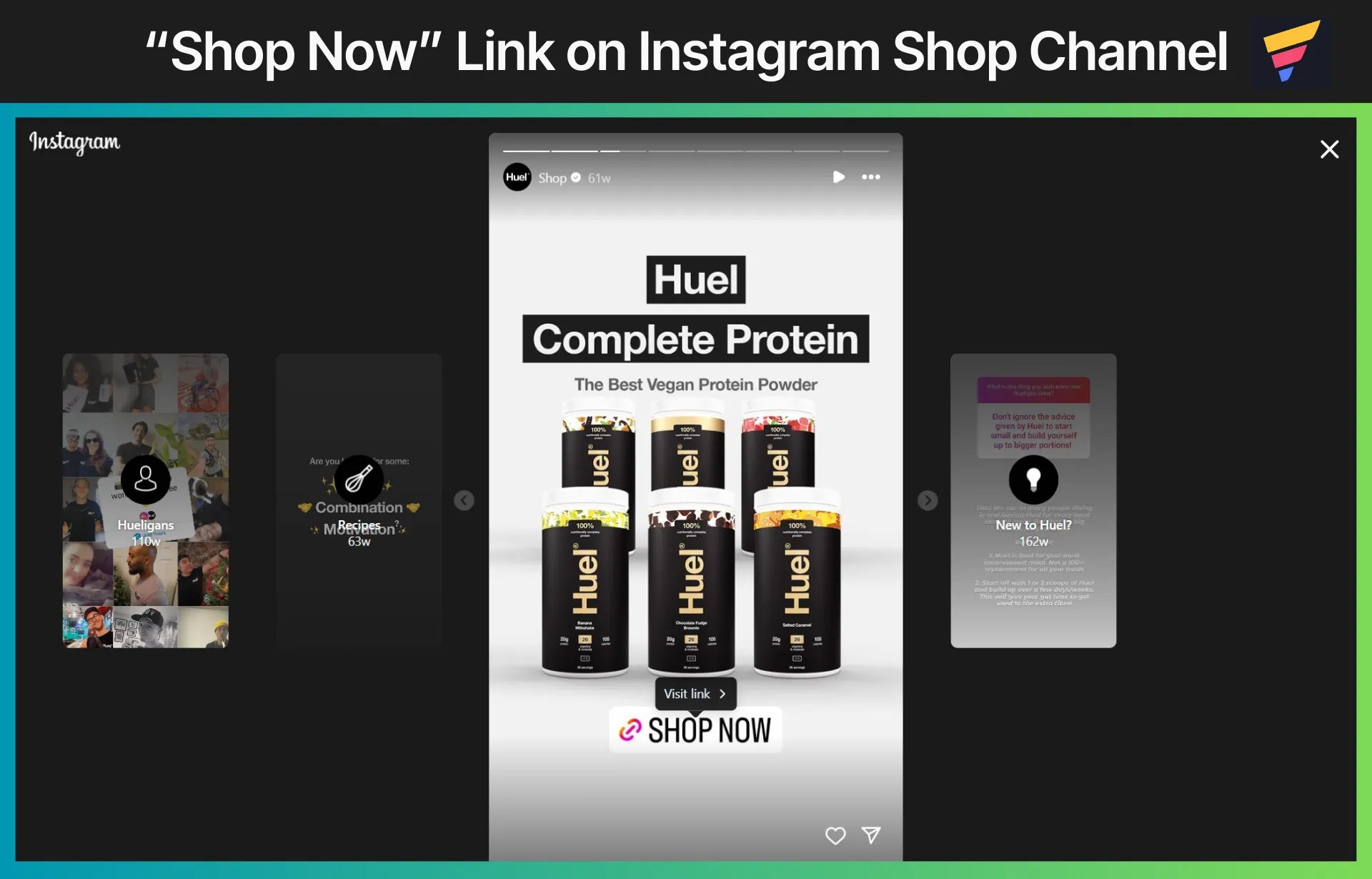
Upon clicking on the link given in the Shop channel’s highlighted posts, the customers will land on Huel’s landing page as shown below:

The brand has made sure to help customers make the purchasing decision by providing them with information about FAQs and statements from registered dietitians & nutritionists.
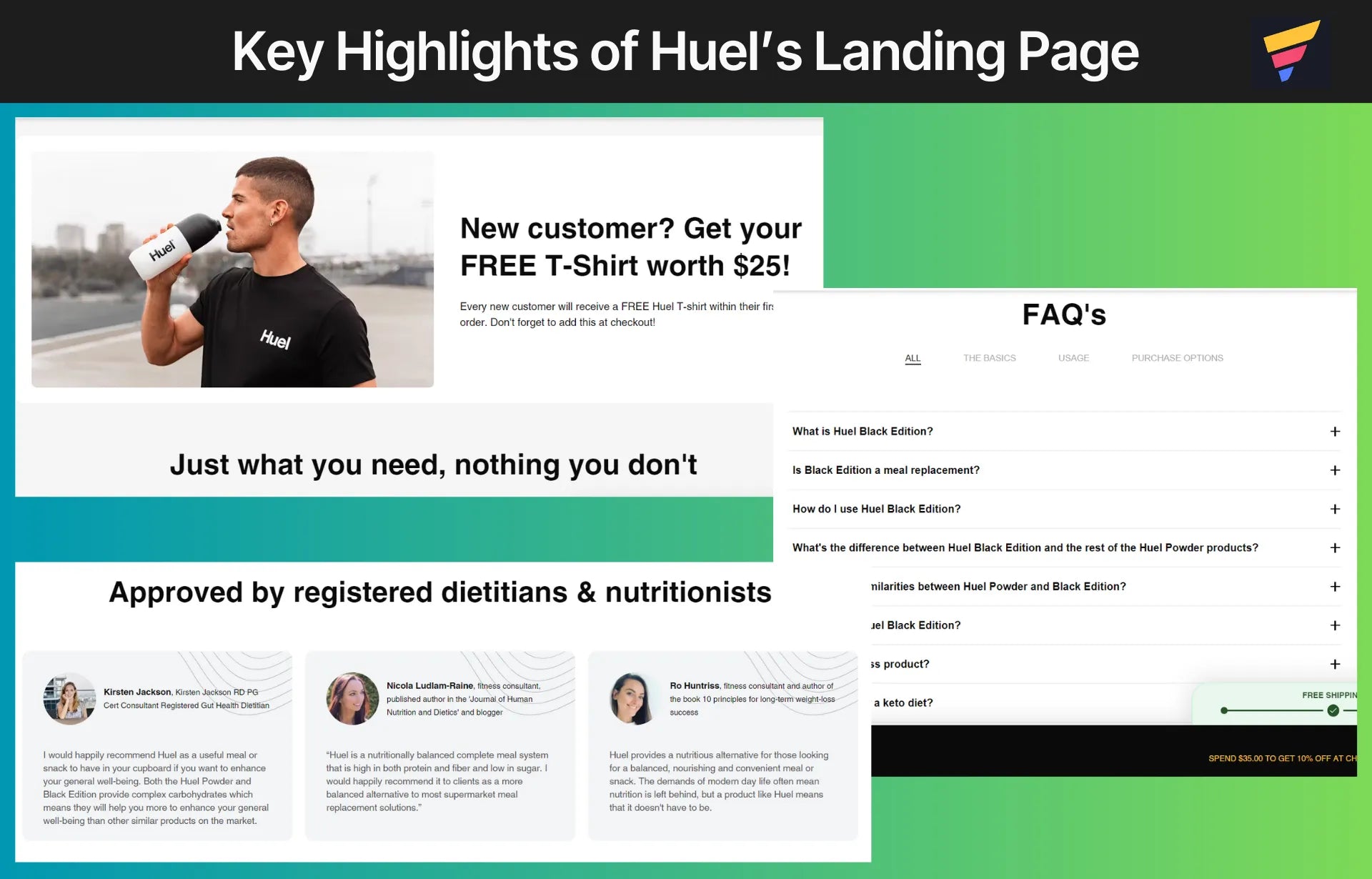
On top of all this, when going through the purchase journey, customers also get the option to sign up for the email newsletter and win a freebie (for new customers upon spending $66 or more).
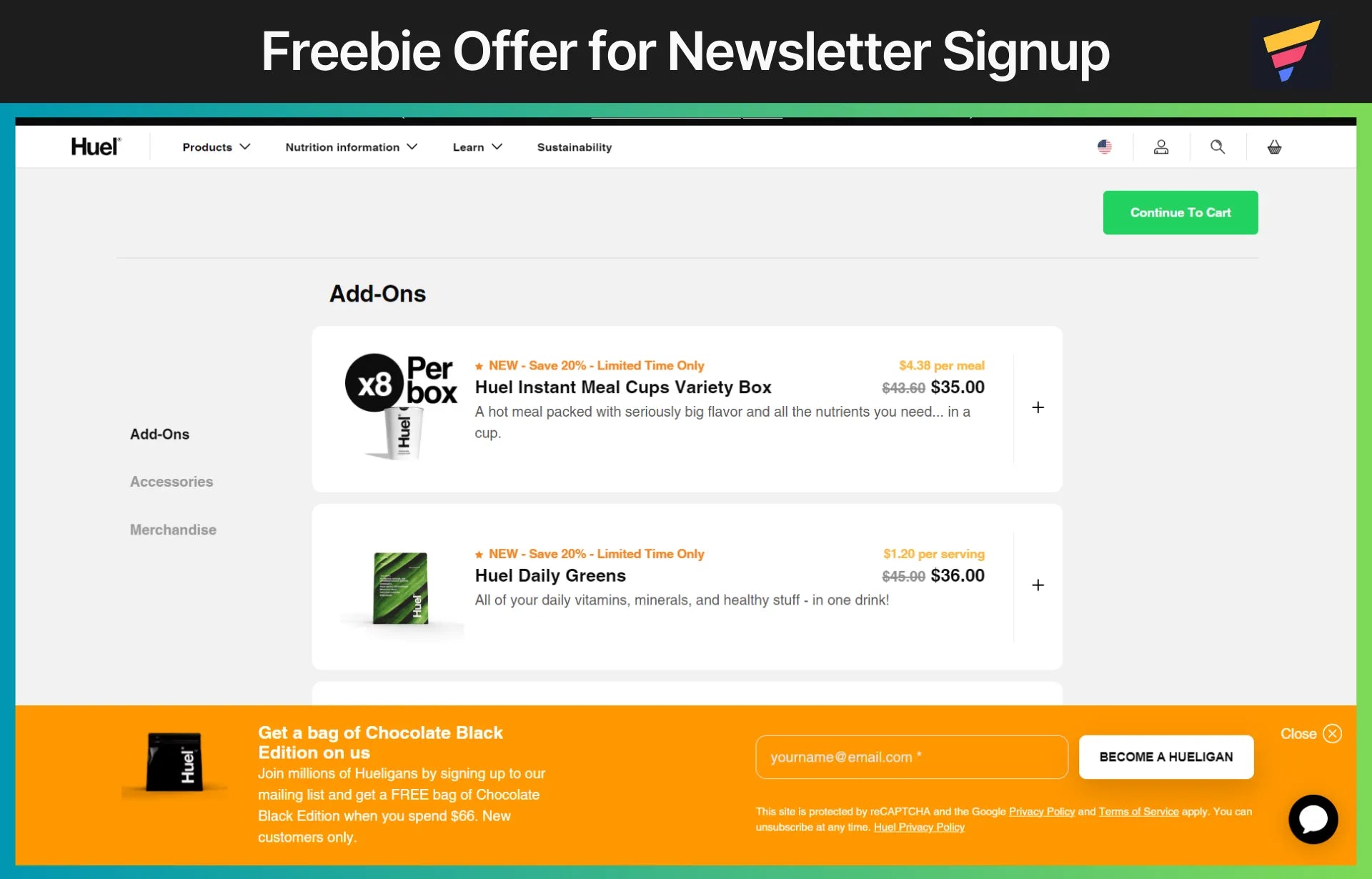
Key Takeaways from Huel’s eCommerce Sales Funnel:
- Great use of organic social media marketing: Instagram is a great channel for organic marketing, meaning without spending on ads, and Huel leverages the platform very well for its sales funnel.
- Conversion-optimized landing page: Huel’s landing page is designed with great details for customers to make the buying decision without any hesitation. For example, social proof and FAQs help customers make an informed decision.
- Upsells and newsletter signup: Throughout the customer’s buying journey, Huel has created multiple opportunities for upselling. Also, adding the newsletter popup enhances the email marketing opportunities as well.
Pro tip: GemPages can help you create conversion-optimized landing pages for your Shopify store. Use advanced features like a drag-and-drop visual editor, AI-powered image-to-layout feature, and an extensive library of professionally designed templates. No coding skills required.
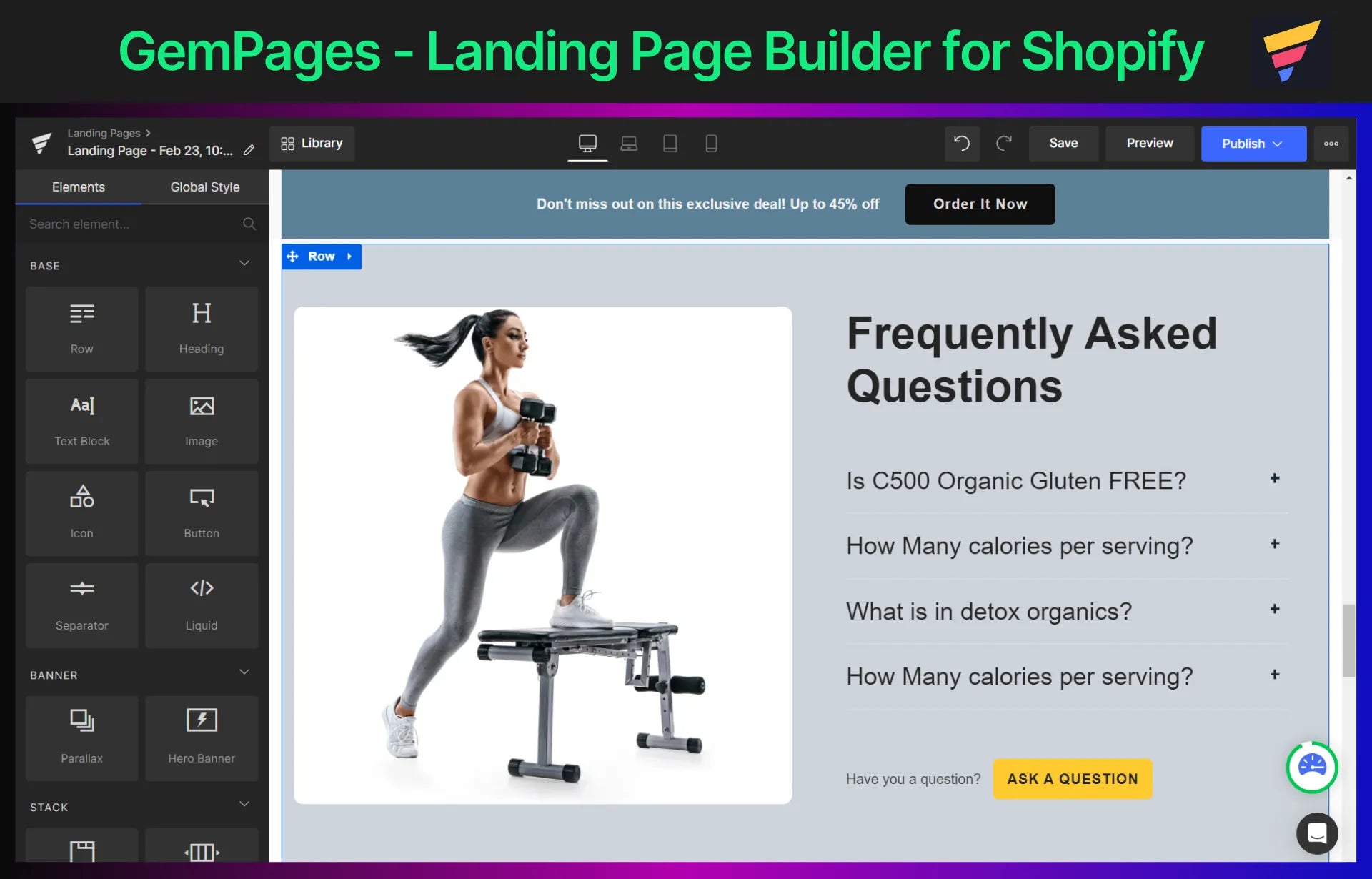
2. Beardbrand’s Sales Funnel with Content Marketing
In 2014, Eric Bandholz — the founder of Beardbrand — pitched its business idea of beard grooming products in Shark Tank for the ask of $400,000 for 15% equity. Unfortunately, he couldn’t seal the deal.
It’s been 10 years and the brand is still going strong. Beardbrand now offers not only beard grooming products but also hair and skincare products.
The brand is also well-known for its solid content marketing strategy, especially its YouTube channel which has over TWO million subscribers. Let’s see how Beardbrand is enhancing its sales funnel through its content.
Beardbrand’s YouTube channel publishes videos around beard and hairstyling guides as well as some entertaining videos. This video went viral and gained nearly 1.5 million views and more than 12,000 Likes on YouTube:
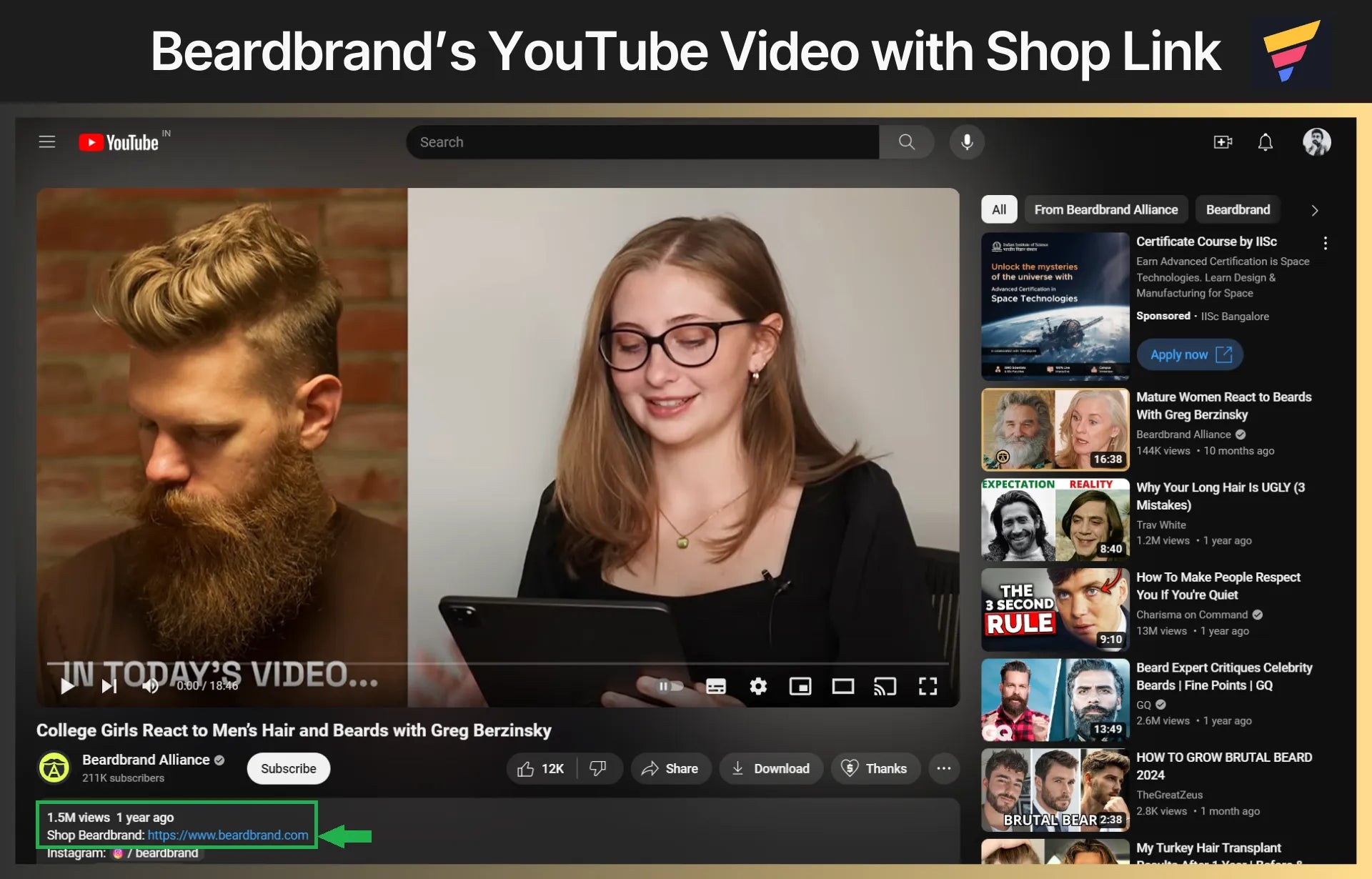
Right at the top of this video description, YouTube users can see the link to the brand’s website. Now imagine the amount of traffic this brand must be receiving from all these YouTube videos.
One more great strategy that Beardbrand applies to keep customers in its sales funnel and to retain existing customers is its “Beardbrand Alliance Membership”. The brand has given a CTA (call to action) on its homepage to entice visitors to join the membership.
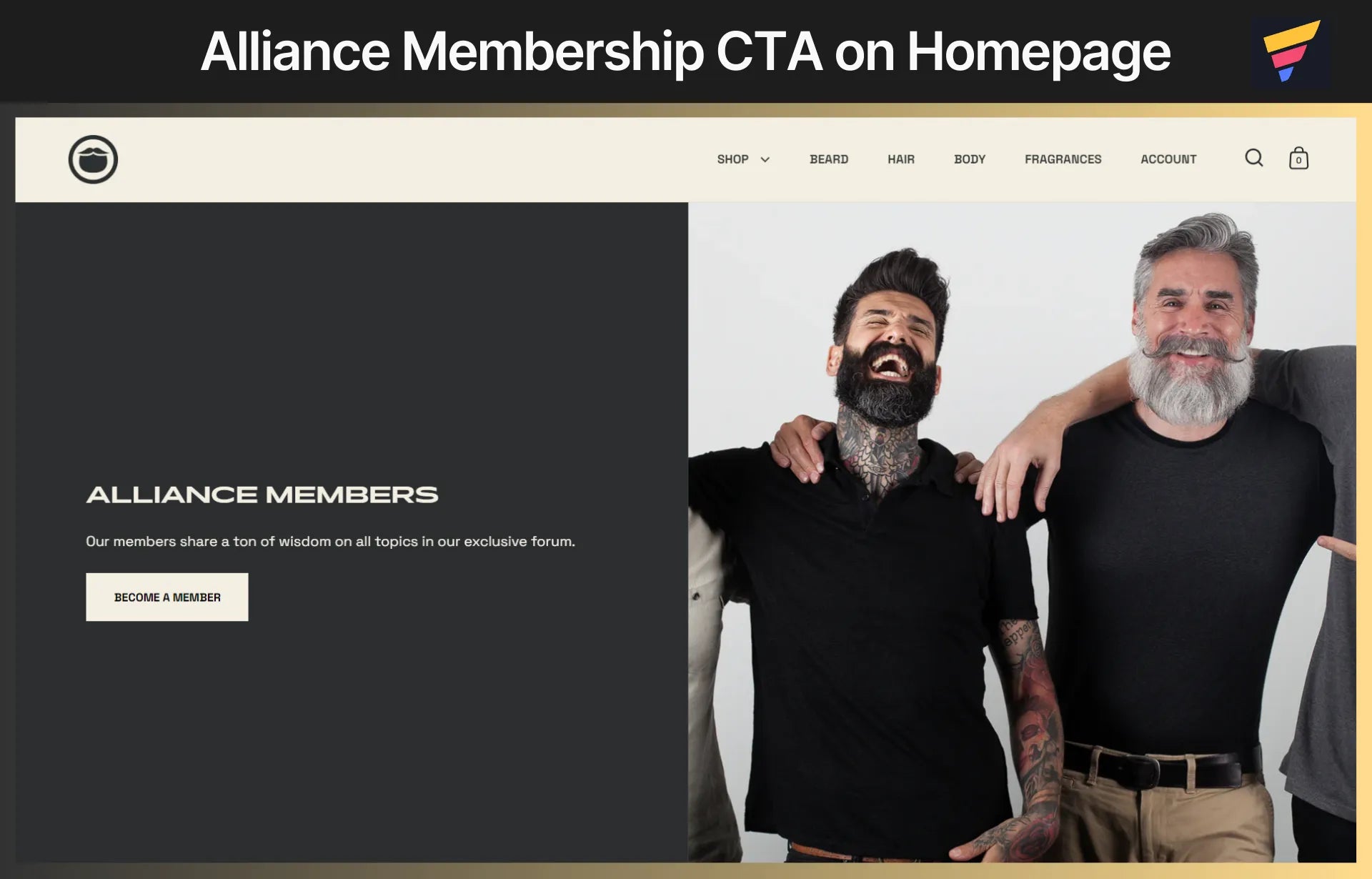
How does this membership work? When you purchase any product three times directly from the Beardbrand store or if you spend $150 or more on a single order, you can become a member of this community. Alternatively, you can enter this membership program for a $90 fee — without purchasing any product from Beardbrand.
Beardbrand also encourages users to text them for a “Free Style Consultation” by sending a text message. This way, the brand also gets the opportunity to implement an SMS marketing strategy more effectively.
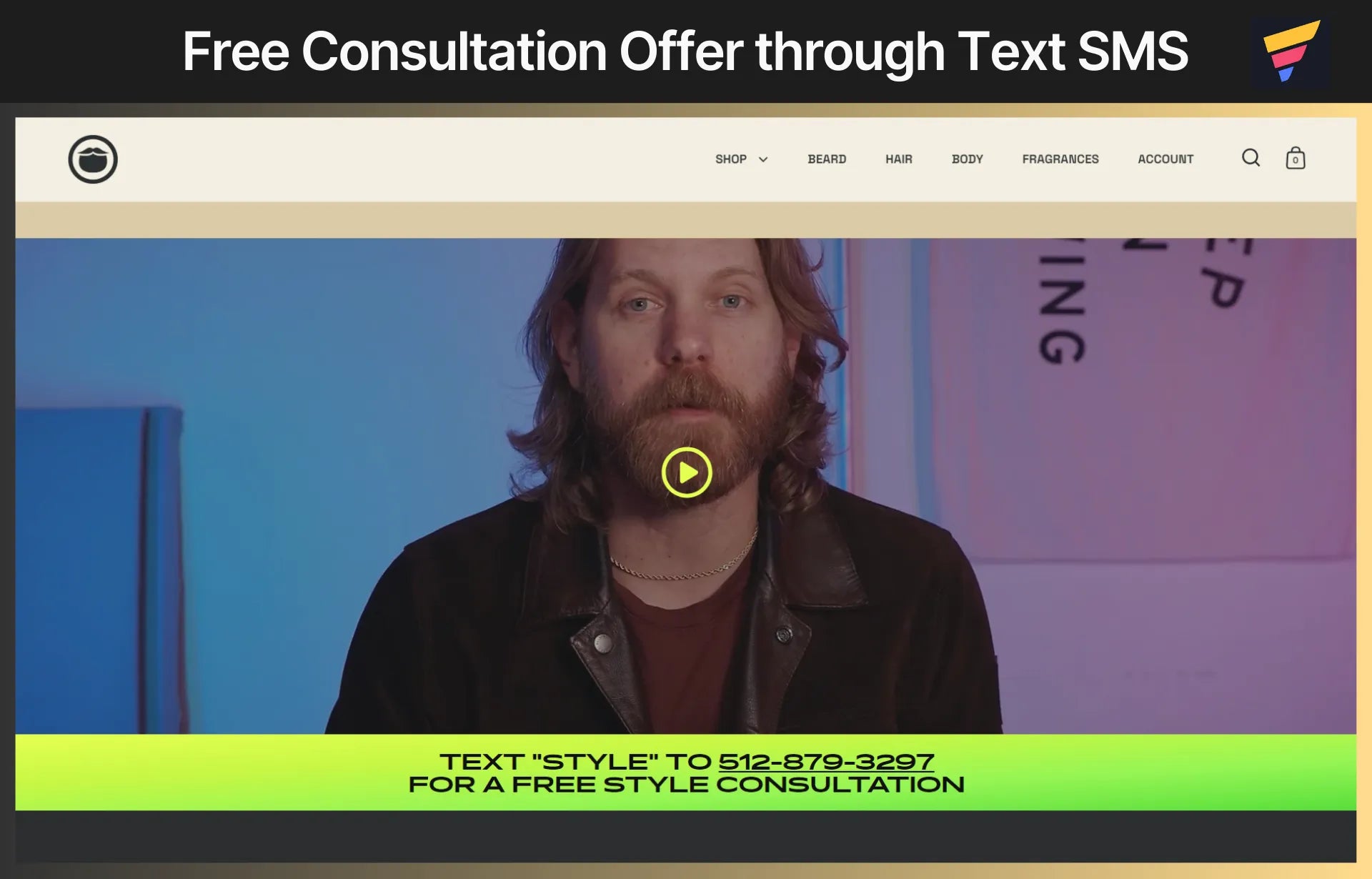
Beardbrand’s blog content is also a crucial part of its sales funnel. The brand publishes blog articles on different topics around beard and styling tips.
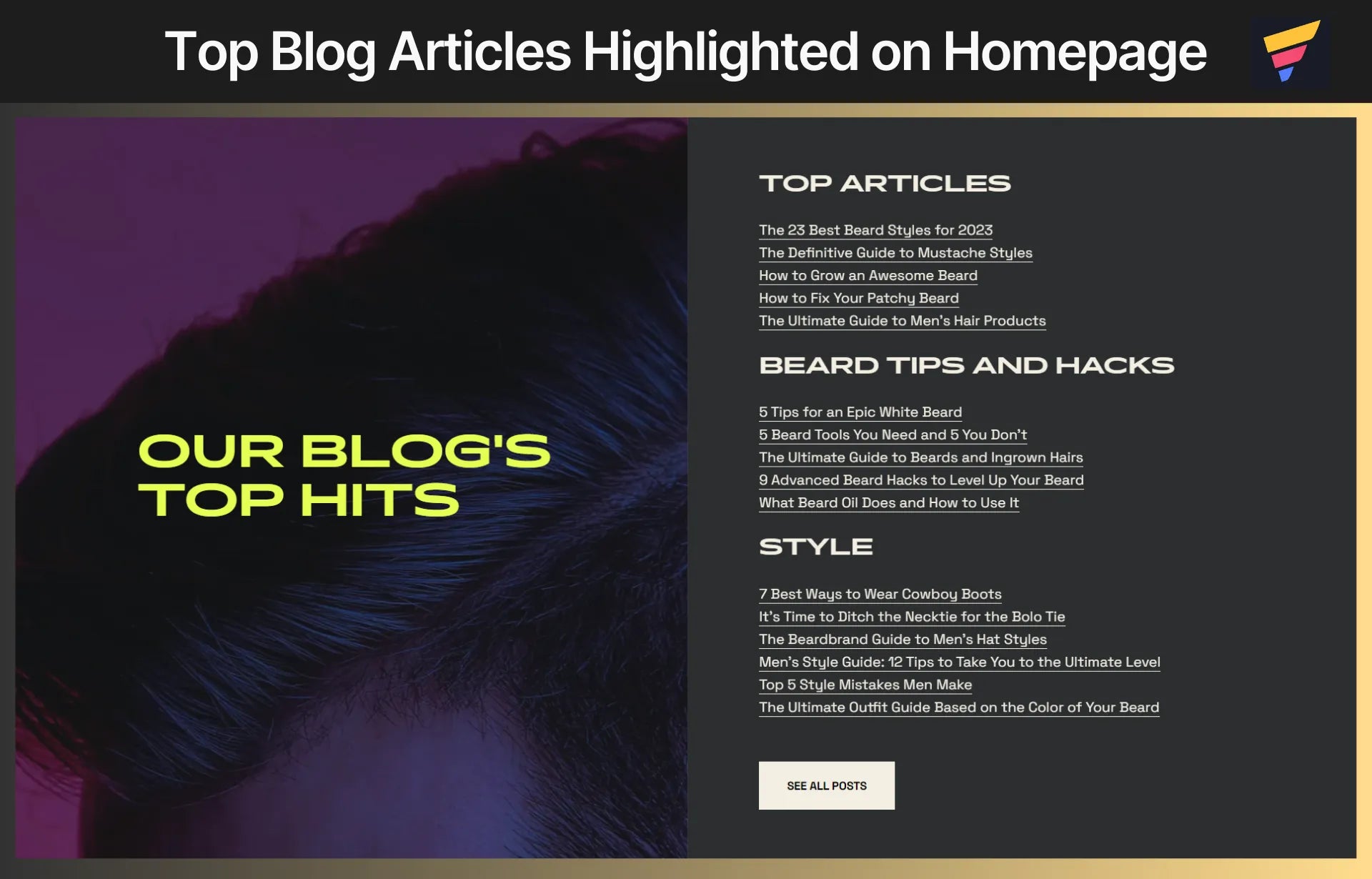
As you can see in the below blog post, it also offers a “Free 5-Week Beard Growth Guide” in exchange for the email signup. This encourages its blog readers to sign up for its newsletter as well.
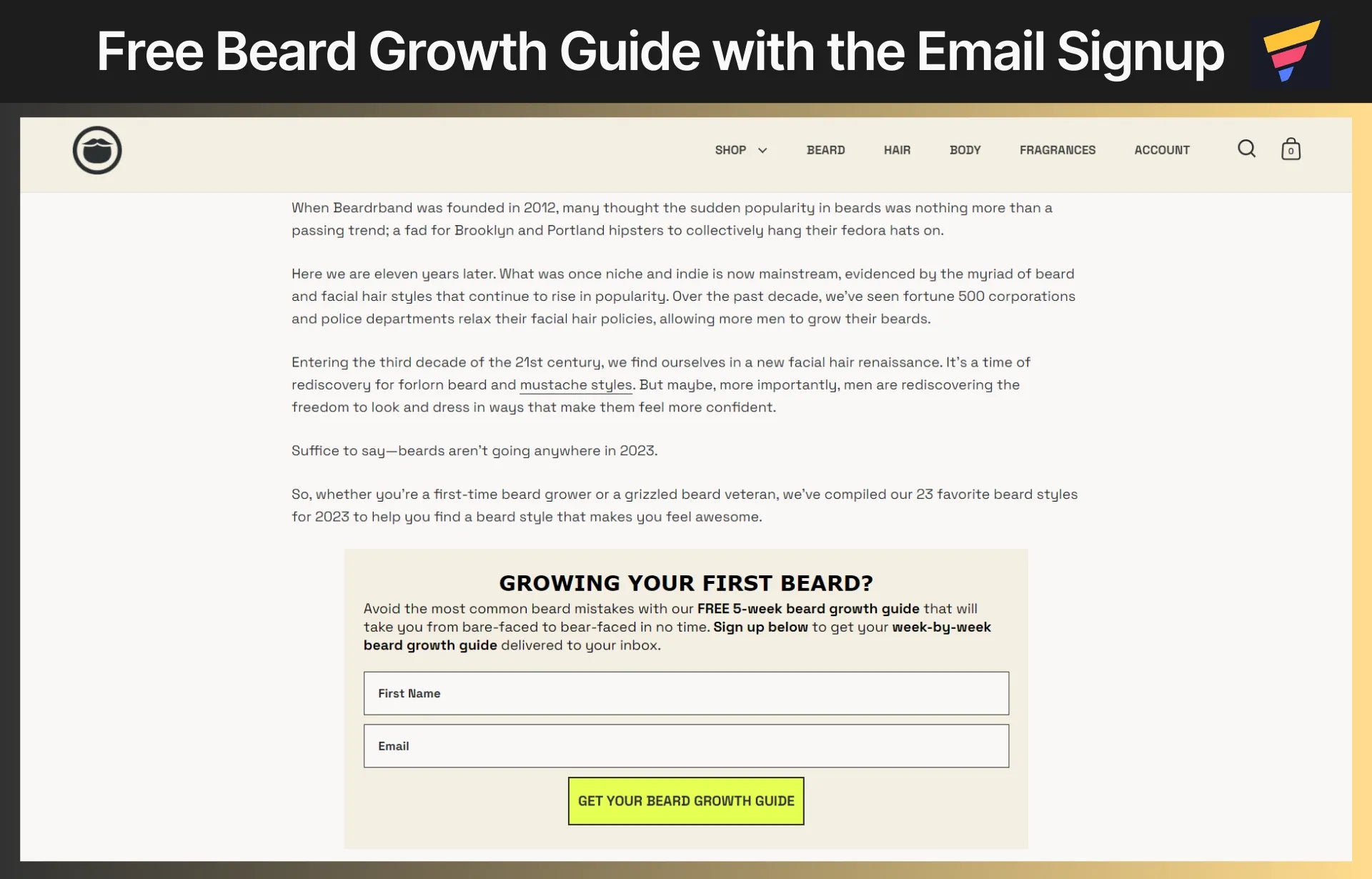
Key Takeaways from Beardbrand’s eCommerce Sales Funnel:
- Solid content marketing strategy: It’s quite evident that Beardbrand has invested in creating a great content marketing strategy that is focused on its target audience. The brand has also maintained a good balance with its educational and entertaining content.
- Community building: Building a community around your customers is a great way to build long-lasting relationships with your customers. Beardbrand’s alliance membership makes its sales funnel robust for retention strategies.

3. Roma’s Sales Funnel with Content Marketing
When searching “best jewelry gift for wife”, Roma Designer Jewelry appears in one of the top results in Google Search — thanks to its educational blog post — “A Husband's Guide to Anniversary Jewelry”.
Once a customer clicks on this blog post link, the customer enters the sales funnel’s “awareness” stage.

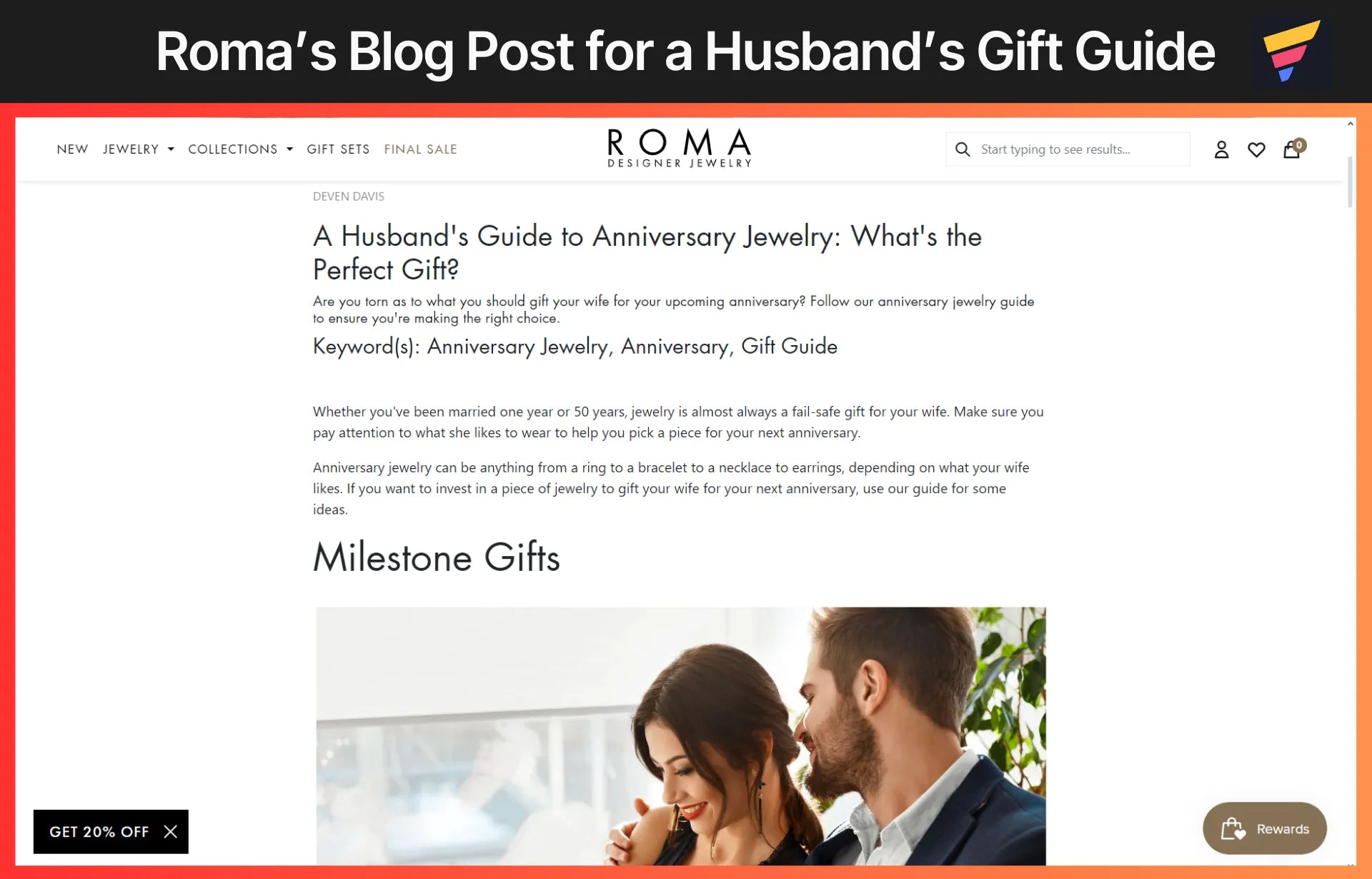
At the end of the blog post, the brand also displays “Shop Instagram Looks” and “Best Sellers” sections to move the customer forward in the sales funnel through the “interest” stage.

Also, there’s a sticky Rewards tab that encourages customers to join the loyalty program and earn rewards. (This could be greatly helpful in the “Retention” stage of the sales funnel.)
At the bottom, the customers are enticed to join the newsletter with a 20% discount offer.
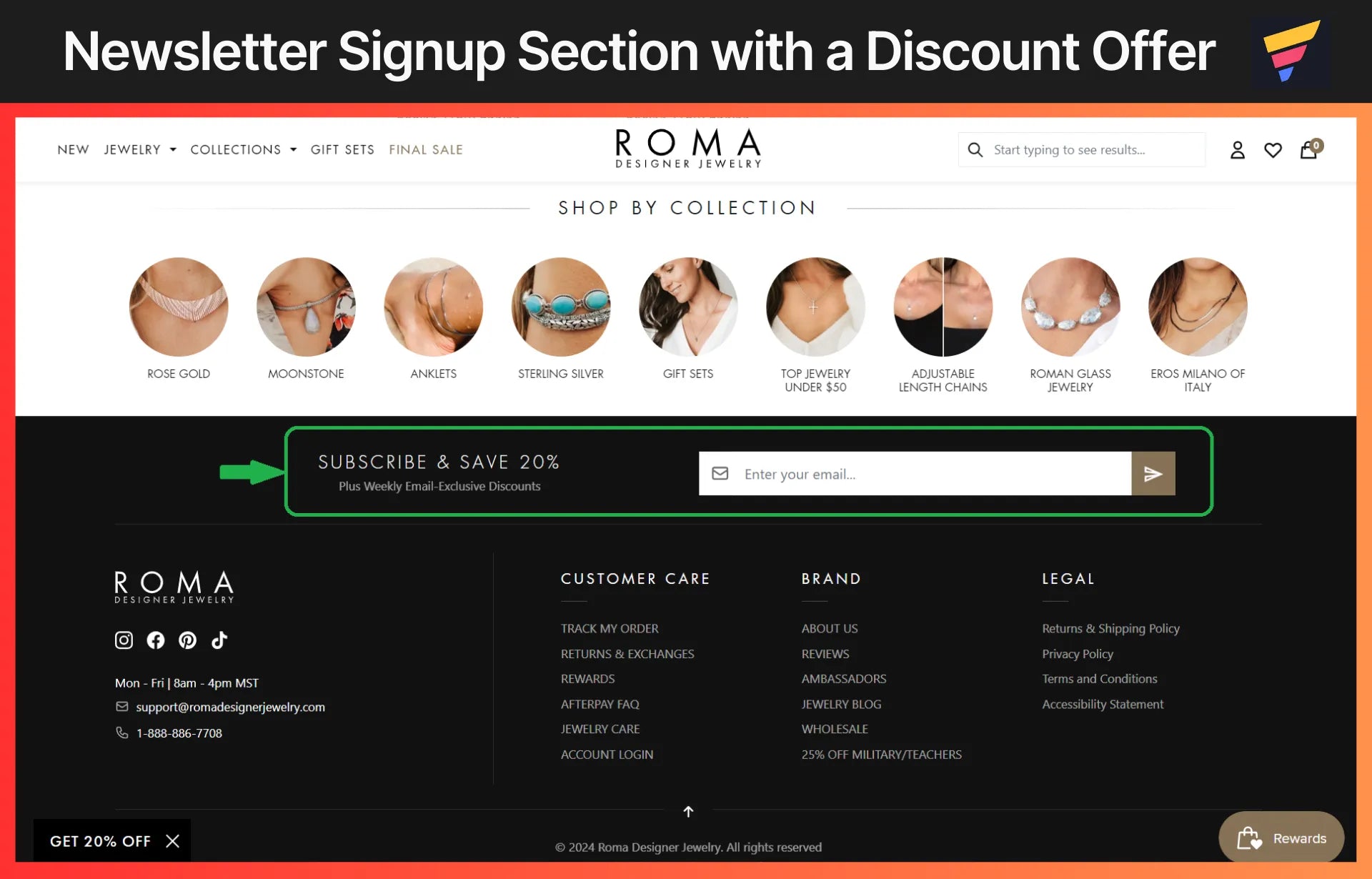
Once customers sign up for the newsletter, the brand gets the opportunity to nurture the leads, move them forward to the “desire” stage, and then convert them into the “Sales” stage.
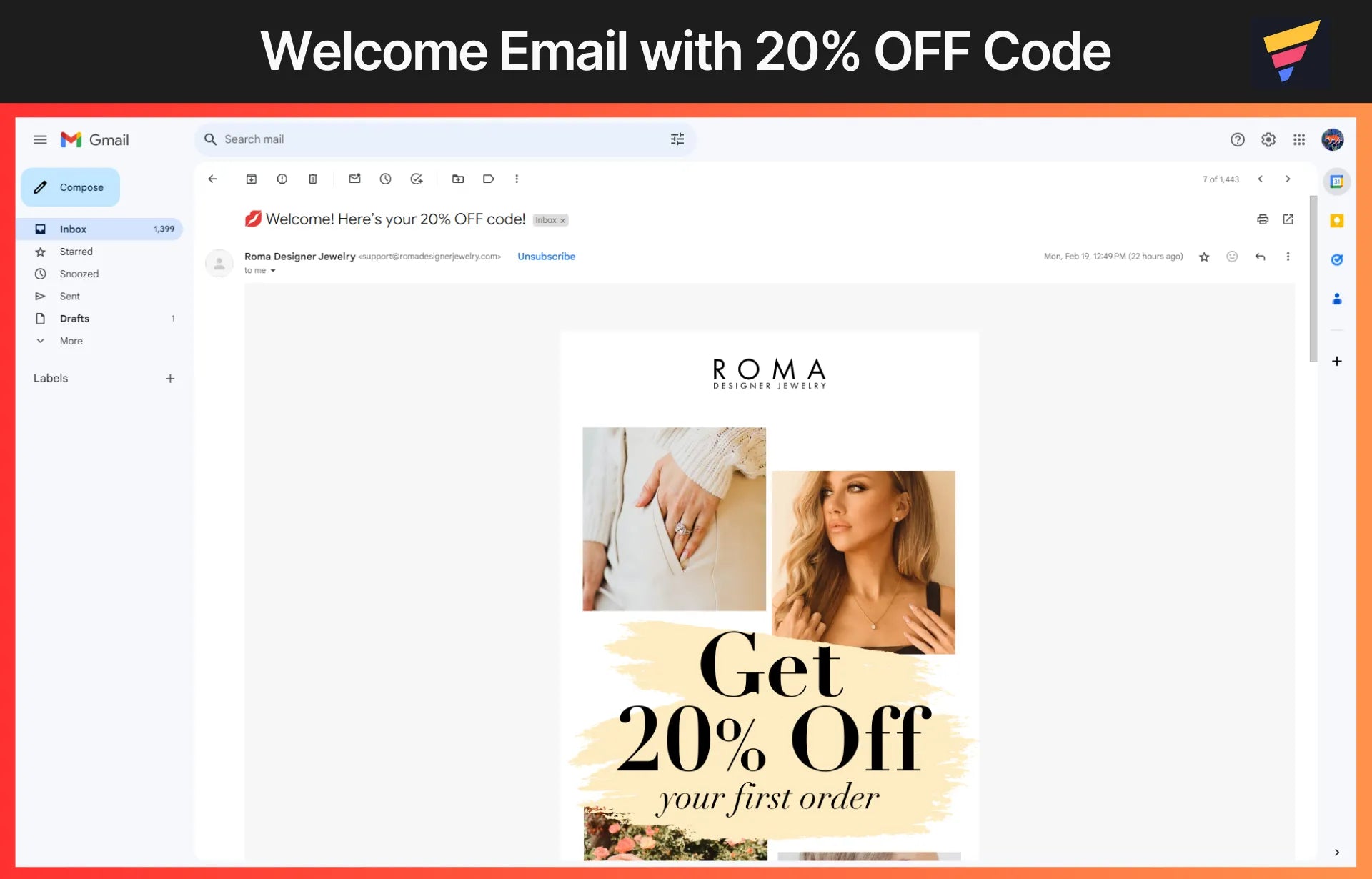
Key Takeaways from Roma’s eCommerce Sales Funnel:
- Multiple entry points: Customers may move forward in Roma’s sales funnel through its rewards program or the newsletter sign-up. While the rewards program is a great strategy to keep customers engaged, the newsletter helps run email marketing campaigns.
- Use of the visual elements: To make sure customers remain engaged throughout the journey, the brand uses great images in its blog content as well as in email content.
- Offering incentives to customers: When asking the customers to join its newsletter, the brand offers 20% off which makes a compelling offer.
4. Absolute Collagen’s Sales Funnel with a Lead Magnet
Absolute Collagen offers marine liquid collagen products for hair, nails, and skincare. The brand has used a smart approach in its sales funnel considering that not all people would know about “collagen”.
So, the brand offers a free collagen handbook on its homepage to build its sales funnel. This handbook provides detailed information on topics such as:
- What is Collagen?
- What does marine collagen do?
- How do we know Absolute Collagen Supplements work?
Another great thing the brand does with its lead magnet (free handbook) is that it also collects information about the specific product(s) the customer is interested in. This is also brilliant because it can help personalize marketing emails.
Learn more: 18 Best One Product Shopify Store Examples in 2026

At the bottom of the handbook, there’s a CTA button that leads to the landing page. On this landing page, the brand offers a free welcome gift worth $35 when a customer subscribes to the 14-day or 28-day subscription of marine liquid collagen.
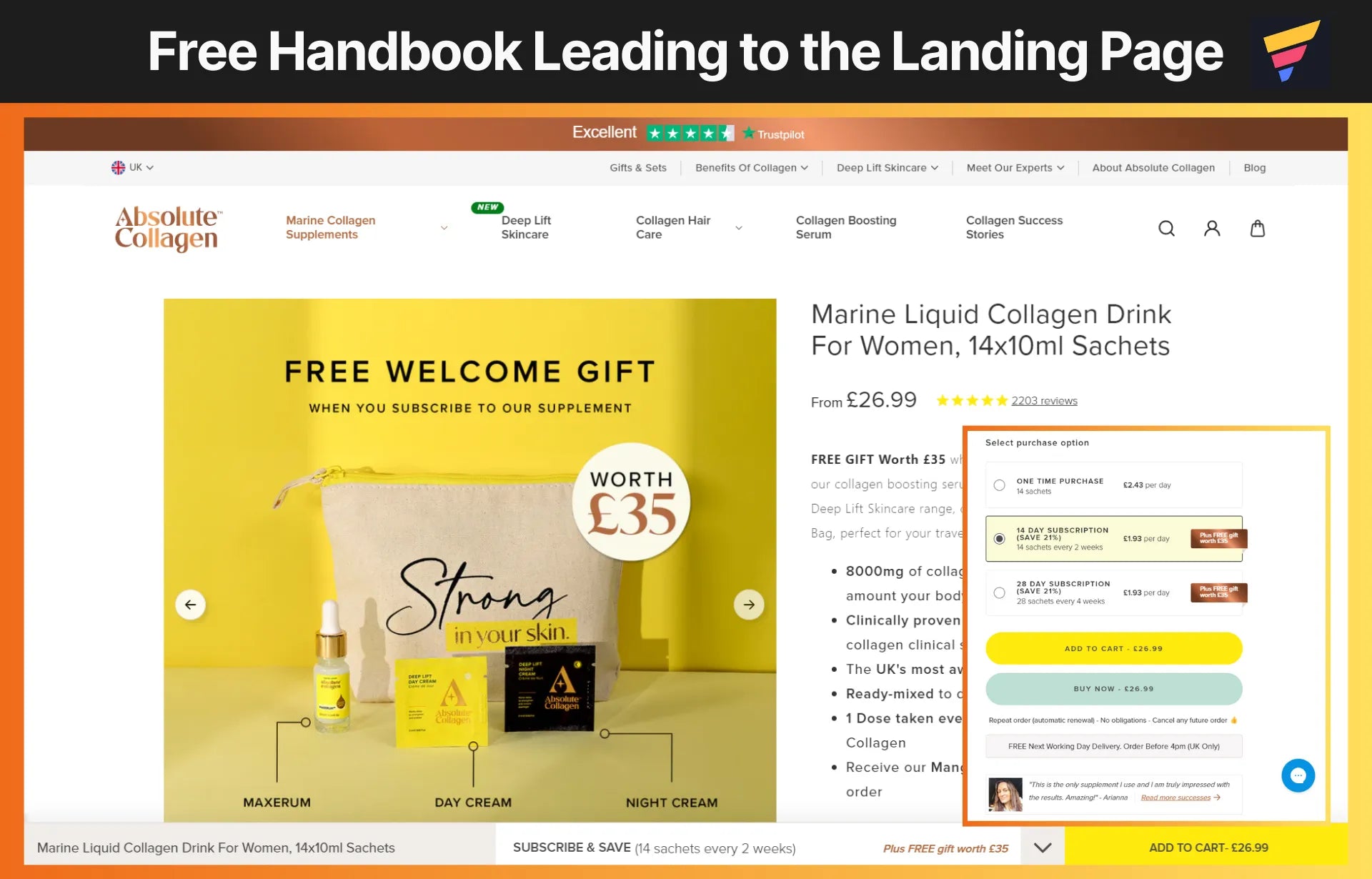
Once you sign up for the free handbook, you’ll receive a welcome email with a short message from Maxine — Absolute Collagen’s co-founder. The welcome email also covers statements from the brand’s collagen experts and a review from celebrity brand ambassador, Emma Willis.
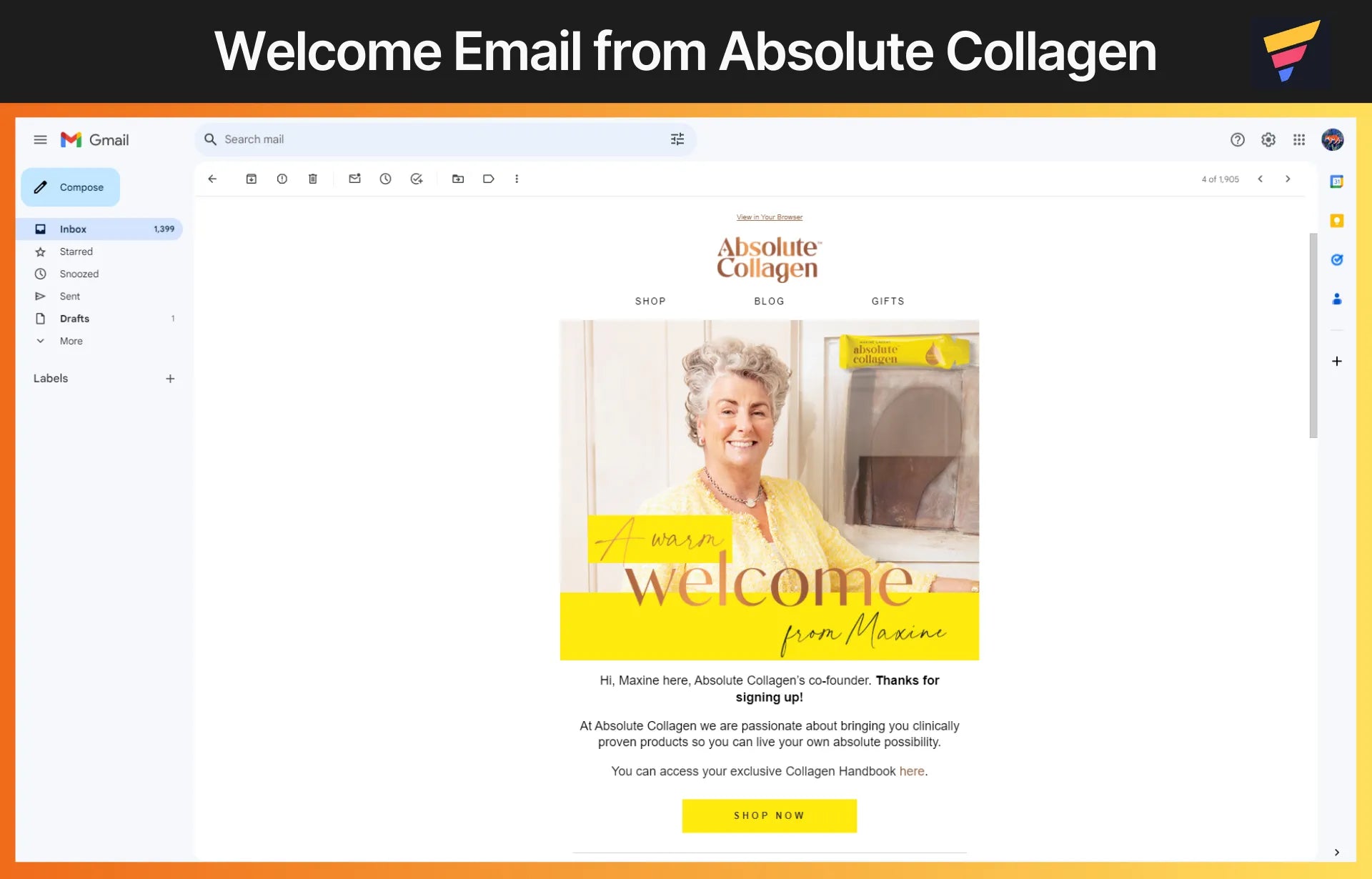
After the welcome email, the brand starts with its marketing campaign for lead nurturing. For example, the below email shows how the brand uses customers’ browsing history (on Absolute Collagen’s website) for personalizing marketing emails.
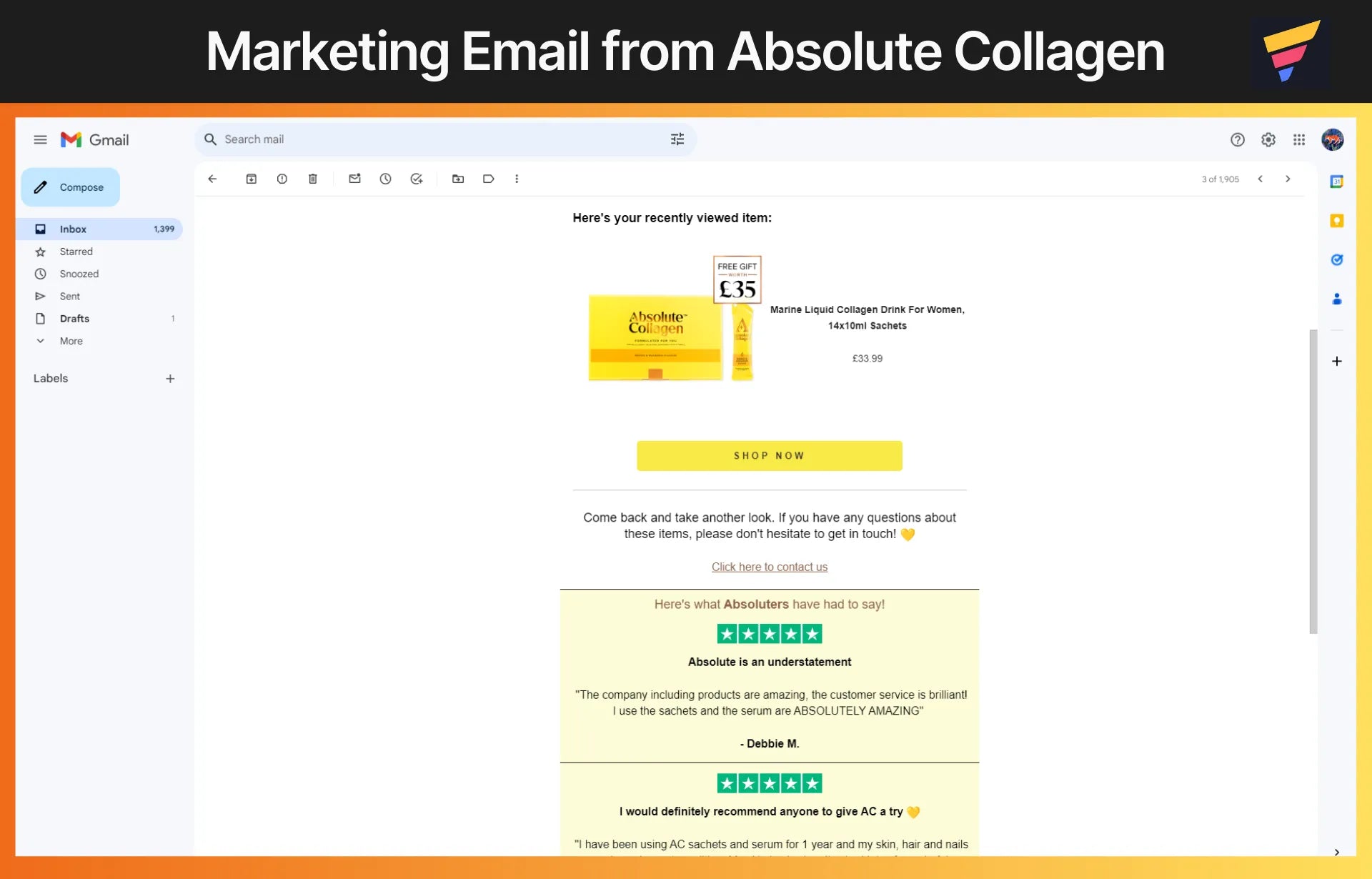
Key Takeaways from Absolute Collagen’s eCommerce Sales Funnel:
- Brand promotion through celebrity influencer: As we’ve seen, throughout the sales funnel, the brand promotes its products through the celebrity influencer or brand ambassador, Emma Willis.
- Highlighting social proof and expert statements: For products like these, you need to ensure that customers feel safe to use the product. Absolute Collagen has taken proper care of it by mentioning all the expert statements and displaying social proof from Trustpilot — a third-party customer review platform.
5. Ruggable’s Sales Funnel with Pinterest Marketing
Ruggable is a home decor brand that offers machine-washable rugs.
Since the brand offers products in the home decor segment, which is all about visual aesthetics, it’s making great use of Pinterest to display tons of home decor inspirations along with its products.
One of the great advantages of using the best sales funnel examples is that Pinterest content also helps rank higher in search engines like Google.
As shown in the below example, upon searching on Google for “home decor ideas with washable rugs”, Google displays Ruggable’s Pinterest page in the top search results:
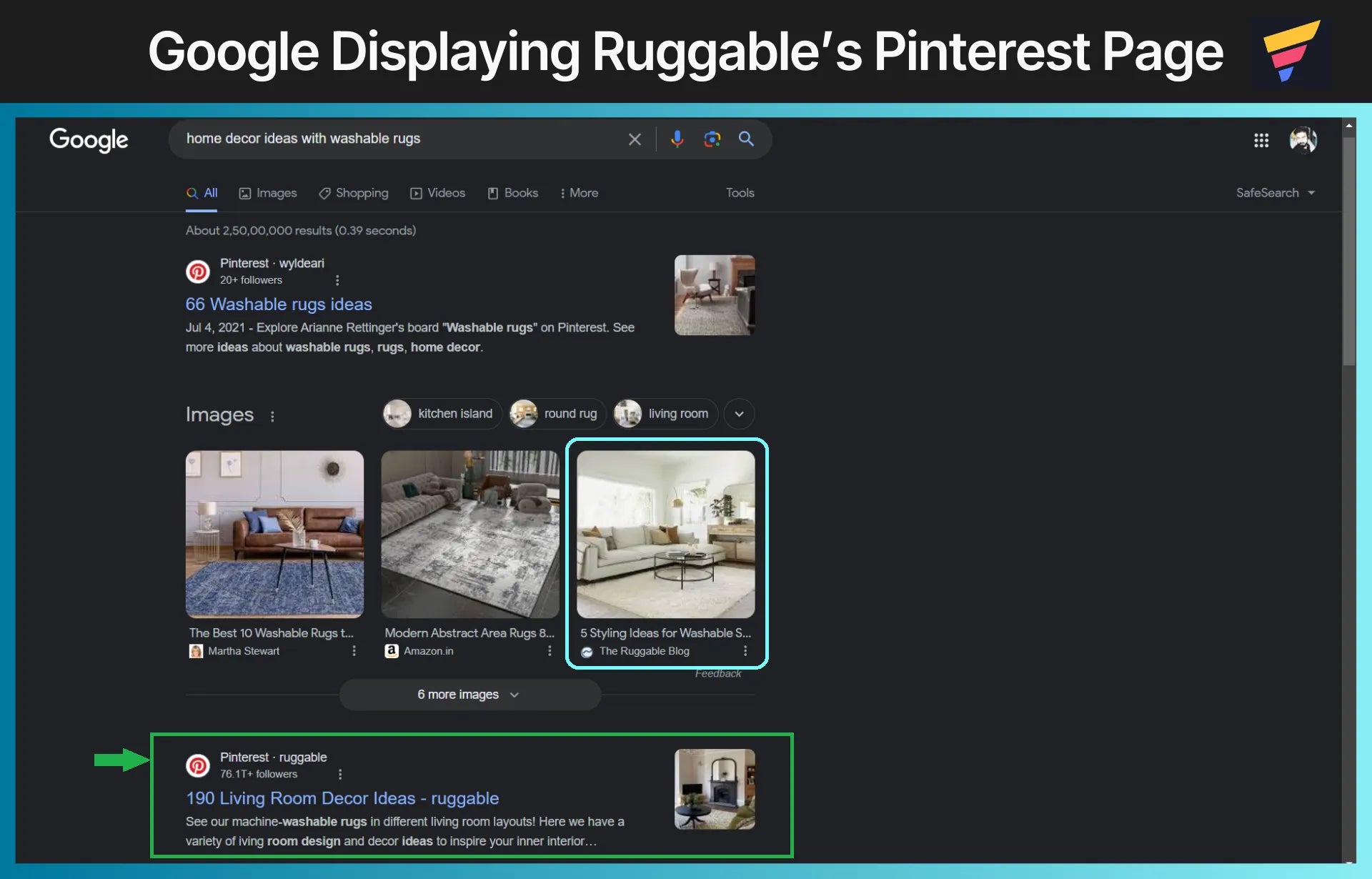
Side note: Interestingly, the Google Search results also showed a blog post from the Ruggable blog. But for this article, let’s focus on the sales funnel built around its Pinterest page.
Upon clicking on the link given in the Google Search results, you’ll land on Ruggable’s Pinterest page with a Pins collection — “Living Room Decor Ideas”.

No wonder Ruggable’s Pinterest page has more than 76,000 followers with such aesthetically pleasing and inspiring home decor images. Now, let’s take a look at the below Pins which are linked to the product pages of Ruggable:
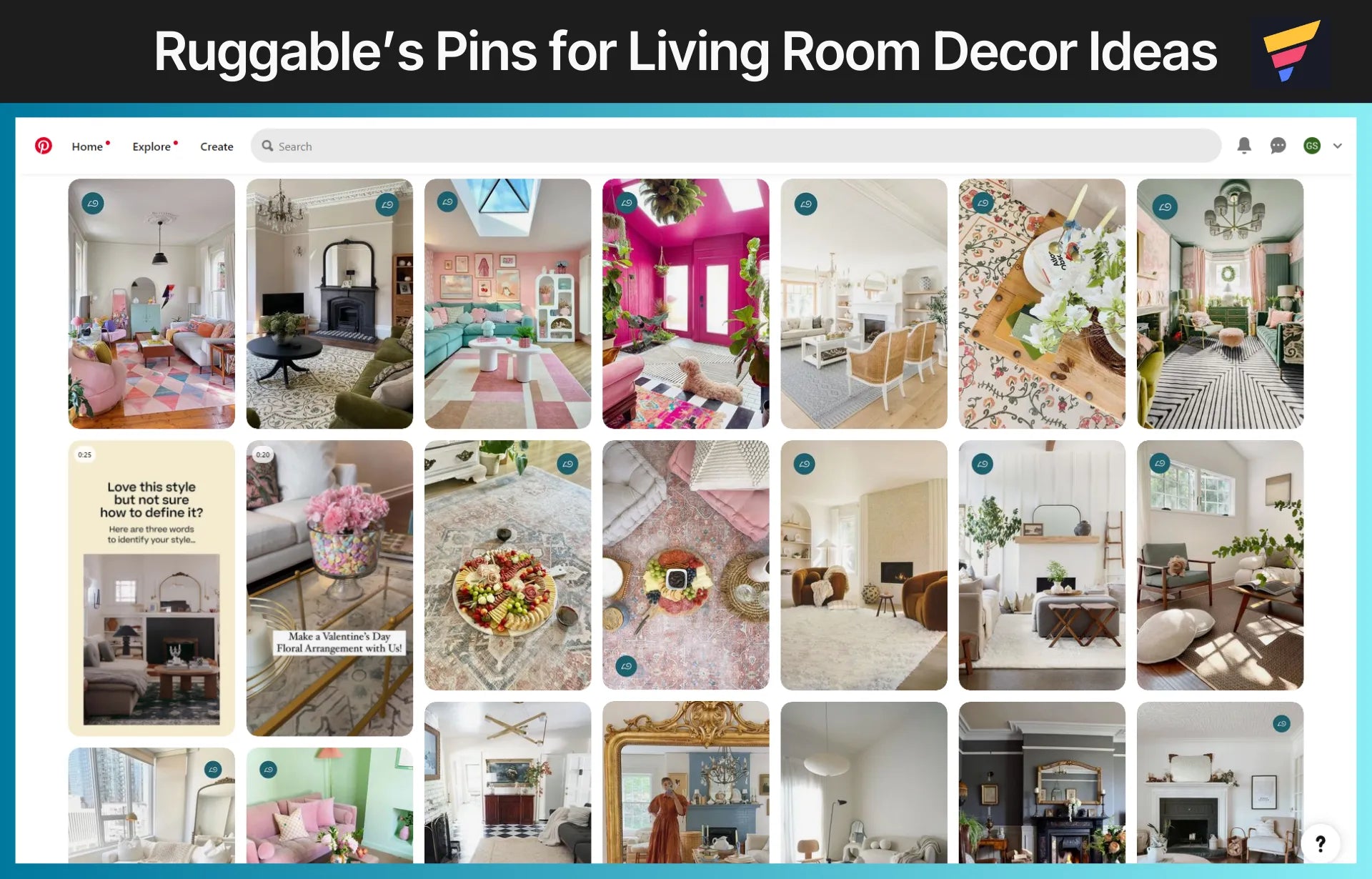
Pinterest users can expand the image by clicking on it, and it will provide more details about the selected image and it also has a link to the product page.

When you click on the link given in the Pin’s title, it’ll lead you to the product page on Ruggable’s website. This way, customers move forward in the sales funnel from awareness to interest stages, and eventually, buy the product.
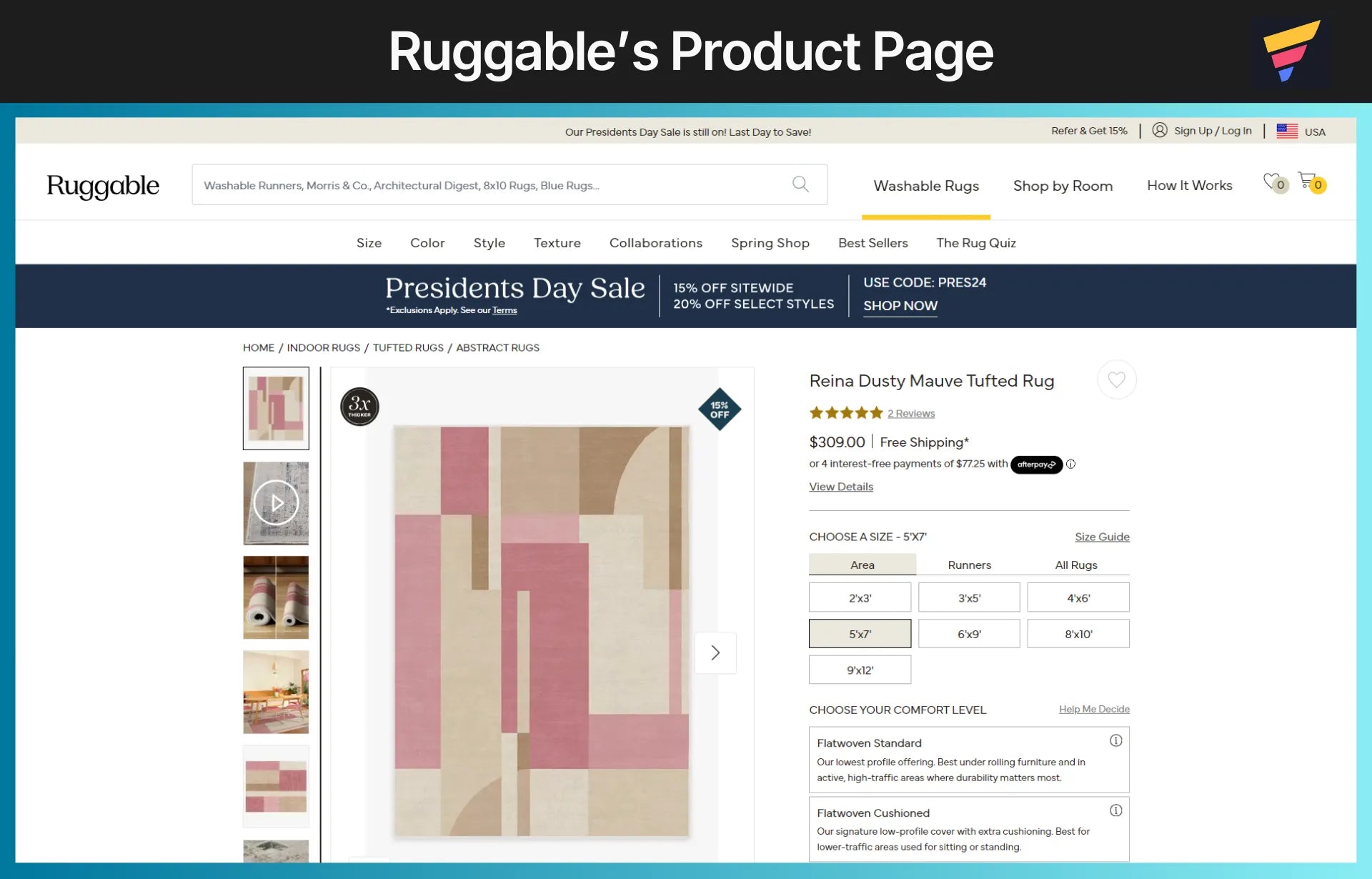
Ruggable’s product page does a great job of displaying the features and benefits of its product with visual elements such as lifestyle images and videos.
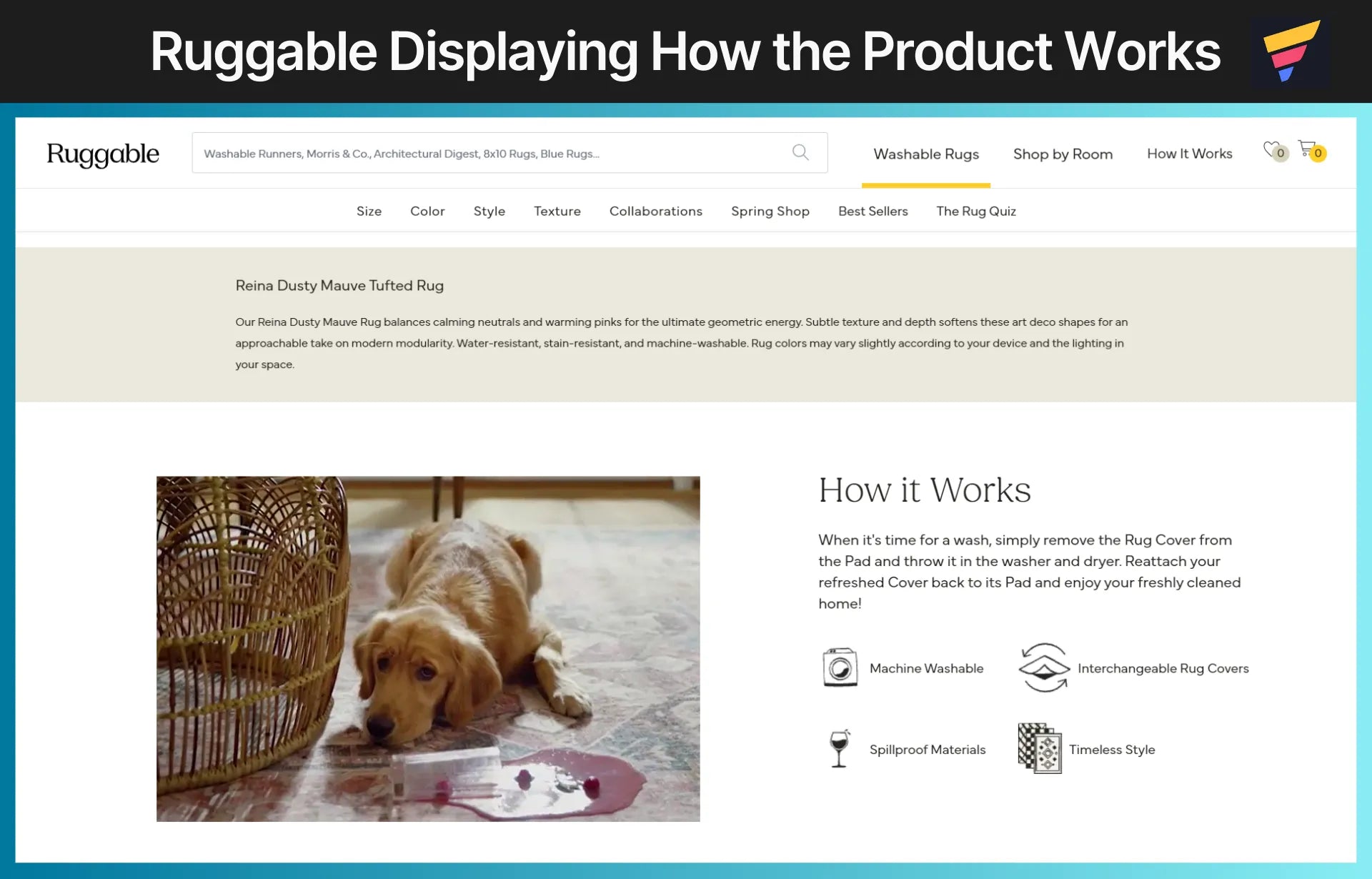
Key Takeaways from Ruggable’s eCommerce Sales Funnel:
- Use of the right platform based on product type: People often go to Pinterest to find cool design inspirations. And thus, Pinterest is one of the best platforms to promote home decor products.
- Showing the product in action: When buying any product online, customers love to see how the product may look or work in real life. Ruggable does a great job at this not only through its Pinterest content but also through its product page.

Best Practices to Create a High-Converting Sales Funnel
-
Use the best sales funnel builder tools and software.
A sales funnel builder helps you create and manage your sales funnel. Use GemPages page builder with Shopify and create stunning landing pages to optimize your sales funnel. Also, you can use Shopify Flow to automate lead nurturing.
-
Display social proof on your landing pages.
Social proof such as customer reviews, press mentions, expert reviews, awards, and recognitions help during the “Interest” and “Evaluation” stages of your sales funnel.
-
Use valuable content and great copy.
Once potential customers enter your sales funnel, the next thing you need to make sure is that they don’t leave your funnel. And that’s where your website copy and content play a crucial role.
-
Create specific content for each level of the funnel.
A sales funnel is mainly divided into three levels: ToFu (Top of the Funnel), MoFu (Middle of the Funnel), and BoFu (Bottom of the Funnel). When creating content for your sales funnel, keep in mind that each of these levels requires a different type of content.
-
Monitor the performance of your Shopify sales funnel.
Post creating your sales funnel, you must regularly monitor its performance to see if you’re making a good return on investment. Use data from your eCommerce funnel platform and Google Analytics 4 (GA4) to analyze the performance of your sales funnel.
-
Fix any funnel leak issues as and when needed.
Any weak areas in your sales funnel will divert your potential customers to a different route altogether. For example, if you’ve created a valuable blog post but there’s no CTA to join the newsletter, you’ll lose some of those customers when they switch to other blog articles.
Final Thoughts on eCommerce Sales Funnel
While reading this article, did you visualize the areas where you can optimize your sales funnel? If yes, great, it’s time to execute the ideas.
OR even if you’re looking to start building your sales funnel from scratch, we’ve got the tools and resources to help you build one. Check out a guide on how to build an eCommerce sales funnel strategy and choose the best sales funnel builder tools and software.
Join the GemPages Facebook community to learn and share ideas or challenges with real experts and entrepreneurs of the eCommerce game.




 Facebook Community
Facebook Community Change Log
Change Log Help Center
Help Center







![How to Build a High-Converting Facebook Ads Funnel [2026]](http://gempages.net/cdn/shop/articles/Facebook_Ads_Funnel-thumb_7a583f1a-80ec-4b88-bdd8-3724e5fb0740_480x480.webp?v=1767078937)




